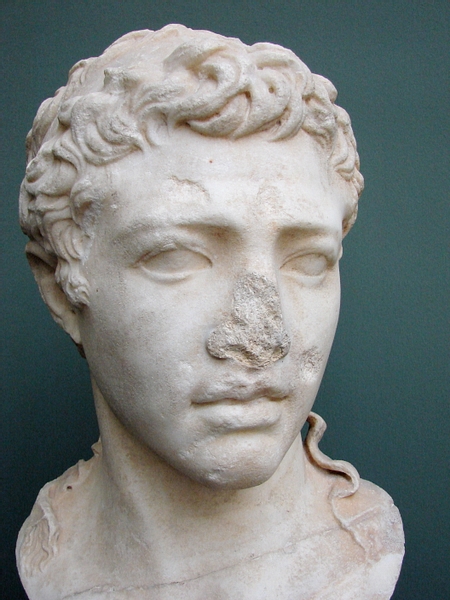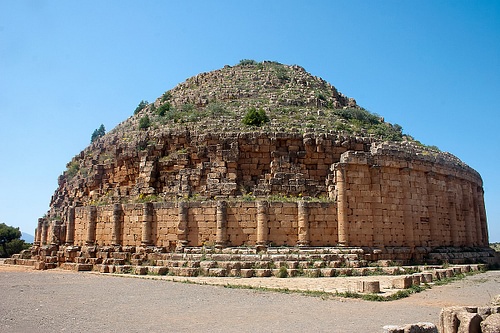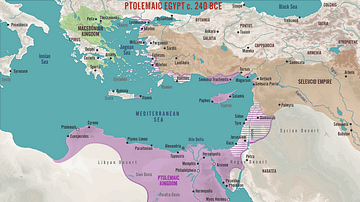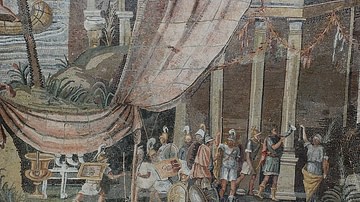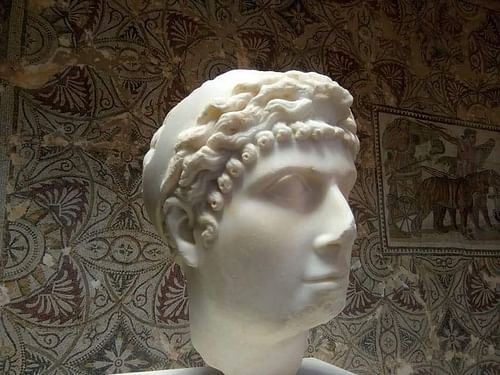
Cleopatra Selene II (40 - c. 5 BCE) was a member of the Ptolemaic Dynasty who became the queen of Mauretania upon her marriage to King Juba II of Numidia (48 BCE - 23 CE). Though more obscure than her famous mother, Cleopatra VII (69-30 BCE), Cleopatra Selene II was a capable and respected ruler in her own right. She is considered one of the last great queens of the Hellenistic period, part of a long tradition of powerful women that included Arsinoe II Philadelphus (l. c. 318/311 - c. 270/268 BCE).
Cleopatra Selene II and her twin brother Alexander Helios (40 - c. late 1st century BCE) were the children of the Roman triumvir Mark Antony (83-30 BCE). Cleopatra Selene II’s contemporaries claimed that she was her mother’s equal in charm and intelligence and that she surpassed her in beauty. Much of Cleopatra Selene II’s early life was spent in Alexandria, Egypt. After Augustus (r. 27 BCE - 14 CE) conquered Egypt in 30 BCE, he took Cleopatra Selene II and her brothers back to Rome as his captives. Cleopatra Selene II was fostered by Augustus’ sister Octavia Minor (69-11 BCE) in Rome. She married Juba II of Numidia c. 25 BCE, and they permanently moved to Mauretania.
Early Life & Ancestry
Cleopatra Selene II and her twin brother Alexander Helios were born in Alexandria, Egypt in 40 BCE. They were the first of three children born to the Roman statesman Mark Antony and the Ptolemaic Egyptian queen Cleopatra VII. Through her mother, Cleopatra Selene II was of Greek heritage, descended from the Ptolemaic ynasty of Egypt. On her father’s side, Cleopatra Selene II was descended from the Antonii, an aristocratic Roman family that traced its roots to the establishment of the Roman Republic.
Antony was forced to leave Egypt shortly before their birth to attend to matters in Italy. In 40 BCE, Mark Antony married Octavia Minor, the sister of his rival Octavian (the future Augustus). Cleopatra Selene II and her brother were raised by their mother in Alexandria with their half-brother Caesarion (47-30 BCE), the illegitimate son of Julius Caesar.
Donations of Alexandria
Cleopatra VII travelled to Antioch in 37 BCE to meet with Antony, bringing her children in tow. This was the first time that the three-year-old Cleopatra Selene and Alexander Helios had ever met their father. Antony likely gave them their surnames of Helios and Selene at this meeting. Cleopatra Selene II’s surname was likely inspired by Cleopatra Selene I of Syria (r. 82-69 BCE), a Seleucid monarch of Ptolemaic descent. Her brother was named after the sun god Helios, whose sister was the moon goddess Selene. Mark Antony and Cleopatra VII’s third and youngest child Ptolemy Philadelphus was born later that year.

Between 36 and 34 BCE, Mark Antony reorganized the eastern Mediterranean, distributing large territories among his children by Cleopatra in the process. At the Donations of Alexandria in 34 BCE, Cleopatra Selene II was made queen of Cyrene (encompassing part of modern-day Libya) as well as parts of Crete. This was mostly symbolic, as her mother Cleopatra VII was the de facto ruler of these territories. Alexander Helios was betrothed to the Armenian princess Iotape, but Antony made no such arrangements for Cleopatra Selene II. Given her young age, a betrothal was not yet a priority for her parents.
Conquest of Egypt
After the Donations of Alexandria, the conflicts between Octavian and Antony escalated until Octavian convinced the Roman Senate to declare war with Egypt in 32 BCE. This conflict, known as the Final War of the Roman Republic, ended with the defeat of Antony and Cleopatra at the Battle of Actium in 30 BCE. With defeat imminent, Cleopatra made overtures with Octavian to negotiate for her life and the lives of her children. Keenly aware of his advantage, Octavian refused to make any guarantees prior to his subjugation of Egypt in the summer of that year. After the conquest of Egypt, Cleopatra Selene II and her brothers were left orphaned as both of their parents committed suicide.
Before her death, Cleopatra VII made arrangements to send Caesarion to India, and her remaining children, including Cleopatra Selene II, were sent further into Egypt, where they would be out of the reach of Octavian. Cleopatra Selene II’s older brother Caesarion was nominally king of Egypt for a few days after Octavian captured Alexandria but was executed by Roman soldiers while attempting to flee the country.
Life in Rome
Cleopatra Selene II and her remaining brothers were taken by Octavian who brought them to Rome. Ptolemy Philadelphus likely perished before reaching Rome, as only the twins were paraded as captives in Augustus’ Roman triumph. The pair were dragged behind an effigy of their mother committing suicide by clutching an asp to her breast.
With a huge pomp of triumphs, Augustus entered Rome, and led before his chariot the children of Cleopatra, the Sun and the Moon. (Eusebius, Chronicle 2.140, transl. Roger Pearse and friends)
Augustus relented in his treatment of them after the triumph, having taken the opportunity to show them off as prisoners of war. Rather than treating the twins as prisoners, Augustus cared for both as though they were his own family. He gave custody of them to his sister Octavia Minor, who raised them with her own biological children. Alexander Helios disappeared from the historical record almost immediately after arriving in Rome. It is assumed that he too died at a young age, leaving Cleopatra Selene II as the only living descendant of Cleopatra VII.
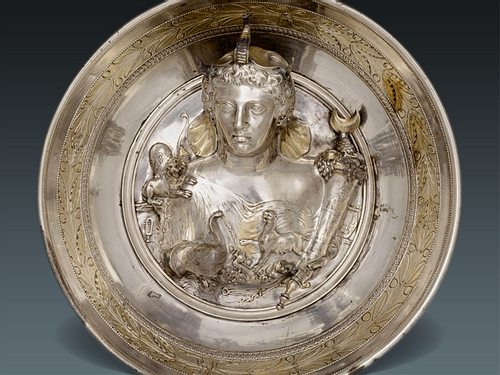
Cleopatra Selene II’s upbringing in the household of Octavia meant that she was raised among relatives, including many of her paternal half-siblings. Little is known of this portion of Cleopatra Selene II’s life, besides the fact that it was comfortable. Octavia ensured that all royal children in her household received an education of the highest quality and that suitable marriages for them were arranged.
Marriage to Juba II of Numidia
While living in the house of Octavia, Cleopatra Selene II met her future husband Juba II. As an infant, Juba II had been taken hostage by Julius Caesar (100-44 BCE) and was raised by Caesar’s family. The teenage Juba II was residing in Octavia's household when Cleopatra Selene II was brought to the city. Juba II and Cleopatra Selene II grew up together for a time in the household of Octavia.
The two immediately had a lot in common. Both were young royals orphaned by Roman conquest and effectively exiled from their homes in North Africa. They also shared a passion for Hellenistic culture and intellectual pursuits. By the 20s BCE, Juba II was already a notable scholar in the fields of history and geography. Cleopatra Selene’s influence on Juba II’s work has been noted, particularly in regards to his scholarship on African history and geography. When Cleopatra Selene II came of age around 25 BCE, Octavia arranged a wedding between them. This match was orchestrated with the approval of Augustus, who sought to marry each of them to a dynast of equal status.
Queen of Mauretania
Upon their marriage, Augustus appointed Juba II and Cleopatra Selene as client-kings of western Numidia and Mauretania, a wealthy region in northwest Africa. Mauretania was wholly unorganized at the time; its previous two monarchs had died by 31 BCE after years of fighting bitterly over the country. Rome was too preoccupied to pay much attention to the region, so Augustus turned it over to Juba II and Cleopatra Selene II as a dowry. After their wedding, the two left Rome and moved to the city of Iol, Mauretania. The city was in decline when Cleopatra Selene II and Juba II arrived, and they set to work lavishly rebuilding it. They re-established Iol as their new capital, renaming it Caesarea in honour of Augustus.
The new city was laid out on a Roman grid plan, which was both efficient and aesthetically rewarding. Expensive public works, such as a gymnasium, Roman baths, and a theatre were constructed to promote Roman culture in the city. Cleopatra Selene II’s reign brought a decidedly Greco-Egyptian flavour to Mauretania, adding to the already cosmopolitan local culture which was influenced by Berber and Phoenician rulers. These Mediterranean influences were especially apparent in the two major cities, Caesarea and Volubilis.
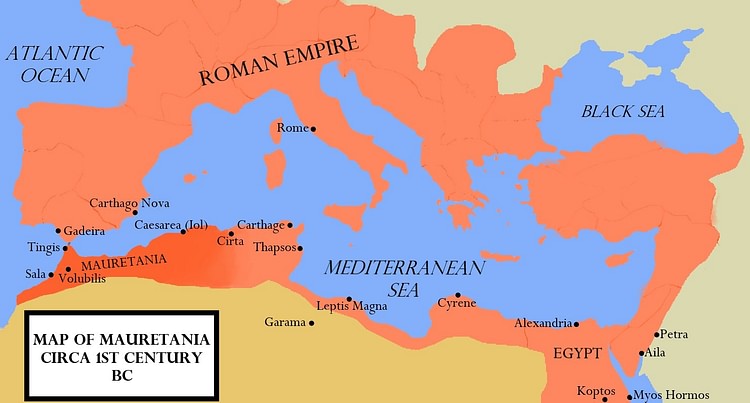
Greek art and architectural designs mingled with Roman design, in a blend that characterized the cultural landscape of much of the Mediterranean during the 1st century BCE. Motifs of Egyptian architecture such as sphinxes and block statues are apparent in 1st-century BCE Mauretania. Genuine Egyptian art, such as statuary dating from as far back as Thutmose I (r. 1504-1492 BCE), was imported to decorate the cities. A great library, modelled after the Library of Alexandria, was established in Caesarea as a testament to the new dynasty’s focus on cultural achievement. Cleopatra Selene II brought over scholars and freedmen who had served the Alexandrian royal court, including poets and physicians. All of this added to the intellectual milieu of Caesarea, which was rapidly becoming a cultural hub.
Under the auspices of the Roman Empire, which now spanned the Mediterranean, the Kingdom of Mauretania was relatively prosperous. Mauretania’s populace began farming more intensively, and trade increased. Mauretania soon became famous for the exportation of goods like timber, grain, and Tyrian purple dye. A lighthouse was constructed in the harbour of Caesarea for this trade, imitating the famous Lighthouse of Alexandria, one of the Seven Wonders of the Ancient World.
Ptolemaic Continuity
Cleopatra Selene II styled herself as a Ptolemaic monarch, the successor of her mother. Her decision to be styled as "Cleopatra, daughter of Cleopatra" proudly displayed her Egyptian heritage. Portraits of Ptolemaic aristocrats and rulers were added to the art collections of the Mauretanian royal court, alongside depictions of the royal family themselves. Cleopatra Selene II’s determination to pay homage to her mother’s legacy was in defiance of Augustan policy, which generally portrayed Cleopatra VII as an enemy of Rome. Despite the prevailing Roman hostility to the Ptolemaic Dynasty at the time, she carved out a space for Ptolemaic court culture to flourish in Mauretania.
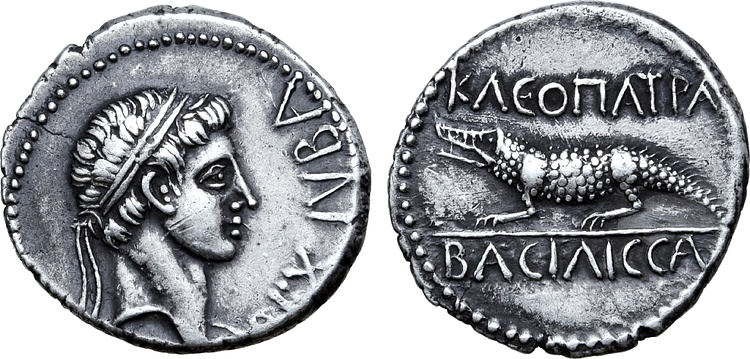
The Mauretanian court was bilingual during this time, with both Latin and Greek in official use. On coins portraying both Juba II and Cleopatra Selene II, Cleopatra Selene II’s legend is written in Greek while Juba’s is written in Latin. She appears on coins as 'Kleopatra basilissa' (Greek for 'Queen Cleopatra'), echoing the titles used by her mother and forebearers. Some coins from her reign feature Egyptian iconography such as crocodiles, sistrums, and the rearing cobra (uraeus) which symbolized Egyptian kingship. Cleopatra Selene II gave birth to a son, Ptolemy of Mauretania, around 10 BCE. By naming him in the tradition of the Ptolemaic Dynasty, she helped to cement the continued legacy of her mother’s family.
Death & Legacy
The exact circumstances of Cleopatra Selene II’s death are unknown, but it is likely that she died of natural causes. After her death, she was buried in the Royal Mausoleum of Mauretania in modern-day Cherchell, Algeria. The Royal Mausoleum of Mauretania was constructed by Juba II and Cleopatra Selene II to house themselves and their future descendants. The structure bears many architectural similarities to the Mausoleum of Augustus.
Controversy exists surrounding the exact date of Cleopatra Selene’s death, which is not recorded. Her death is usually dated to around 5 BCE, as a funerary epigram by Krinegoras of Mytilene, if taken literally, implies that her death coincided with a lunar eclipse. Several other lunar eclipses occurred between 9 BCE and 14 CE, which makes dates based on the lunar eclipse theory uncertain.
The moon herself darkened as she rose at nightfall and veiled her mourning with night,
On seeing her graceful namesake Selene setting breath-bereft into gloomy Hades;
With her she had shared the beauty of her light and with her death she mingled her darkness. (Krinegoras, Greek Anthology 7.633, transl. Maria Ypsilanti)
Juba II married Glaphyra of Cappadocia sometime before 6 CE, by which time Cleopatra Selene II had most likely died. Some historians have put forth alternate interpretations, including the possibility that Cleopatra Selene II and Juba II were divorced sometime before his marriage to Glaphyra, or that Juba II ignored Roman tradition and engaged in polygamy as his Numidian predecessors had. Coins portraying Cleopatra Selene II, and others portraying both her and Juba II, have been found in a coin hoard dating to 17 CE. The discovery of these coins raised the possibility that Cleopatra Selene II lived as late as 17 CE. However, they were in all likelihood a posthumous minting commemorating her reign, perhaps in connection to the succession of her son Ptolemy of Mauretania. Cleopatra Selene II’s lineage lived on through her son Ptolemy of Mauretania (r. 20-40 CE).

